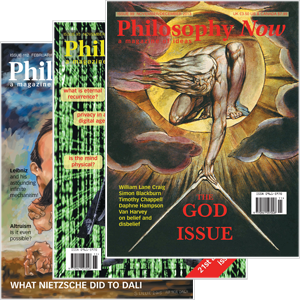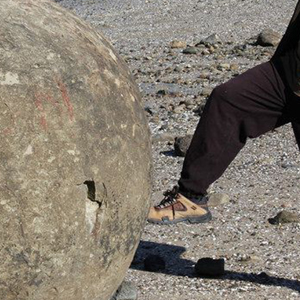
Your complimentary articles
You’ve read one of your four complimentary articles for this month.
You can read four articles free per month. To have complete access to the thousands of philosophy articles on this site, please
Tallis in Wonderland
“I refute it thus”
Raymond Tallis kicks immaterialism into touch.
Readers may be familiar with Bishop George Berkeley’s (in)famous claim that objects exist only insofar as they are perceived. From this it follows that reality consists only of minds and their ideas. Ordinary objects such as cups and saucers and tables and chairs are bundles or collections of ideas, and their being consists in their being perceived by a mind. There is no hidden, mind-independent stuff called ‘matter’. When Berkeley (1685-1753) was questioned as to how objects could continue to be when no-one was perceiving them, he claimed they were still in the mind of God. God’s busy mind also explained how the properties of perceived objects would cluster in a coherent way: how, in the absence of matter, perceptions could still be bundled together into enduring things.
It’s no surprise that these ideas were widely rejected as absurd. Perhaps the most famous dismissal was issued by that standard-bearer for ‘stout common sense’, Dr Samuel Johnson of the original English Dictionary. According to his biographer James Boswell, after he and Johnson came out of church, they
“stood talking for some time together of Bishop Berkeley’s ingenious sophistry to prove the non-existence of matter and that everything in the universe is merely ideal. I shall never forget the alacrity with which Johnson answered, striking his foot against a large stone, till he rebounded from it: ‘I refute it thus’.”
This ‘refutation’ has not cut much ice, even with philosophers who share Johnson’s anti-immaterialism. It seems to say more about his ‘no-nonsense’ attitude than about the nature of the world: it is less of an argument than a harrumph. What, after all, is delivered by Dr Johnson’s kicks? A few perceptions corresponding to the sights and sounds of the interaction between the kicker and the kicked, possibly the pain of a stubbed, gouty toe. Recruiting additional perceptions in this way is hardly going to prove that there is more to reality than perceptions. The stubbed toe may demonstrate that the stone is not an hallucination, but not that it has a material being transcending what is revealed by those perceptions.
In what follows, I want to persuade you that the stone-kicking may deliver more than may be apparent at first sight. This will become clearer if we switch the focus of our attention from the stone that is kicked to the foot that is kicking it; thence to the lexicographer using his foot to make a philosophical point; and, finally, to the interchange between Johnson and Boswell.
Great Things Are Afoot
The interaction between Johnson’s foot and the stone involves parties that seem to be in some respects equals. It is because they are both made of fundamentally the same kind of stuff that Dr J was able to give it a kick, and, if necessary, displace it. Foot and stone are subject to the same laws of nature. Action (kicking) and reaction (stubbing) are equal and opposite.
But the equality of the two participants in Johnson’s ontological drama only goes so far. While the owner of the foot is aware of the stone, the stone is unaware of the foot: and the innocent stone may hurt the foot, but the foot does not hurt the stone. This is a cue to switch attention to the embodied subject, because it is here that we shall find the origin of the ineradicable intuition that objects exist when they are not being perceived, in a generalisation from our own bodies to the material objects with which we engage on terms that are in some respects equal. The flesh in which we are embodied is the primordial example of an object that is in-itself, independent of its being perceived by me – that is, of a material object.

Let me unpack this a bit. At any given time, I have good reasons for being confident that there is more to my body than is being revealed to me by my perceptions of it. The first hint comes from something I have discussed in my book Seeing Ourselves: Reclaiming Humanity from God and Science (2020) – ‘sensory stereopsis’. As I look at my hand resting on a table, I can experience it in ways that lie beyond vision – via a sensation of warmth or pressure on its surface, for instance. This reminder that there’s more to what’s out there than is delivered to one particular sensory channel is our first hint that there may be something beyond sensation, since it highlights the difference between a real object and mere sensory constructs. An attempt to stroke the trunk of the pink elephant you’re hallucinating reveals that it is not real. And this was the implicit argument behind Johnson’s ‘refutation’ of Berkeley: his foot did not go through the stone as it would pass through an hallucination. It does not, however, take us all the way to a proof of a material reality beyond sensation. Indeed, to vary Wittgenstein’s metaphor in Philosophical Investigations (1953), relying on this would be like buying a translated copy of a newspaper to check that the news in the original is true.
My own body, however, delivers more to justify the intuition that it has a being that goes beyond perception.
For a start, the extent to which I experientially access my own body is very limited, and variable. Many of my organs, and most of the processes that take place in them, are hidden from me; and yet they are the continuous necessary conditions of my being alive and perceiving anything. I don’t know about you, but my lymphatic system has given me no notice of its essential existence over the many years of my life, but I wouldn’t be without it. More to the point, there is the necessary, if implicit, role of parts of my body of which I am unaware, or only patchily aware, when I perform ordinary actions.
Let us return to our stone-kicker. In order to perform his act of philosophical gymnastics, Dr Johnson has to remain standing as his leg swings towards its target and he declares idealism dead. The standing, as well as the commentary directed at Boswell, would not be possible without a continuous complex body extending between his feet and his head, encompassing a multitude of elements working in extraordinary coordination. He is, nevertheless, unaware of most of the stuff necessary to connect his feet with his head and to elevate his head to the altitude at which it is perched, and of what is, and must be, going on within that stuff.
Hence the (valid) origin and justification of our sense that there is more to reality than our, or anyone else’s, perceptions. The intuition of material reality begins at home – with our own bodies. This inescapable conviction of our being an entity that is not entirely transparent to our sensory systems – to our perceptions – is a lived, not a logical, conclusion.
Bodies, Continued
The seemingly well-founded belief that there is more to the kicked stone than a cluster of perceptions is the other result of the sense that there is more to the kicker’s body than his consciousness of it at any particular time. If we can be confident that our bodies are material objects, then for the reasons given, we can surely be confident that the things we encounter on seemingly equal terms are also mind-independent material objects.
We could develop this further by acknowledging that being embodied in a material entity is a necessary condition of the mind being a viewpoint on, or located in, a particular quarter of the world, and consequently having certain sensations and not others.
Consider the interchange between Johnson and Boswell about Berkeley’s ‘ingenious sophistry’. This conversation would be possible only if the two men were incarnate in objects that are in roughly the same spatial location. What’s more, for Boswell to remember this conversation many years later, there has to be a continuity between the Boswell of the conversation and the Boswell remembering the conversation – a requirement that seems to be best satisfied by the continuous existence of the body that also wrote down his memories – a continuity that requires more than swarms of perceptions to underpin it.
There is, of course, something special about our own body. Unlike any other objects, it is continuously present to us so long as we are conscious. This reinforces the sense already discussed that between the patches of our flesh that are illuminated by our awareness there are stretches of flesh that are no less real for not being thus illuminated. Many of those parts are continuously on standby to be mobilised as crucial for action, even when we are unaware of them.
The American philosopher Willard van Orman Quine embraced the special status of our bodies: he asserted that they “are our first reification: the first objects to be taken as objects. It is on analogy to them that all further positing of objects takes place” (‘Two Dogmas of Empiricism’, The Philosophical Review 60, 1951). Unfortunately, Quine unhelpfully concludes from this that material objects are ‘posits’ on “a comparable epistemological footing to Homer’s Gods.” If, however, we correctly recall our perceptual relationship to our own bodies, it seems unlikely that Dr Johnson’s footwork would merely deliver something as questionable as Homer’s Gods. What’s more, if it is conceded that our bodies are material objects in good standing, then it seems that the entities they interact with – the bodies of interlocutors, not to speak of lesser stuff such as stones, staircases, and the food we put into our mouths – must be of a similar nature. It would seem strange to think that our material bodies could or should spend their lives interacting with clusters of immaterial perceptions.
Perhaps the reader may be getting a little uneasy. My earlier reference to ‘embodiment’ and the ‘embodied subject’ may seem to carry a hint of dualism – a mental subject somehow bonded to a material body. This was where Berkeley began. His philosophical purpose was to banish the dualism of Descartes, Locke, and others. His theological purpose was to instate God as the curator as well as the creator of everything, ensuring everything’s continuing existence, despite the absent-minded (or intermittent-minded) awareness of conscious subjects.
We can, however, set aside these anxieties if we do not privilege the subject over her body or vice versa, and see the ‘I’ and the ‘it’ not as two entities or substances (mind and body), but as the recto and verso of the same entity.
If we widen our gaze so that it can accommodate not only the stone that Dr Johnson kicked with his foot but also the foot that kicked it, the embodied subject who owned the foot, and the conversational exchange recorded by Boswell, we may indeed have assembled enough material to refute Berkeley’s ‘ingenious’ immaterialism.
© Prof. Raymond Tallis 2024
Raymond Tallis’s Prague 22: A Philosopher Takes a Tram Through a City will soon be published in conjunction with Philosophy Now.









